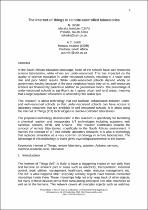JavaScript is disabled for your browser. Some features of this site may not work without it.
- ResearchSpace
- →
- Research Publications/Outputs
- →
- Conference Publications
- →
- View Item
| dc.contributor.author |
Dlodlo, N

|
|
| dc.contributor.author |
Smith, Andrew C

|
|
| dc.date.accessioned | 2011-11-25T08:48:19Z | |
| dc.date.available | 2011-11-25T08:48:19Z | |
| dc.date.issued | 2011-09 | |
| dc.identifier.citation | Dlodlo, N and Smith, AC. 2011. Internet-of-things in remote-controlled laboratories. Proceedings of the 13th Annual Conference on World Wide Web applications, Johannesburg, South Africa, 14-16 September 2011 | en_US |
| dc.identifier.issn | 978-0-620-51918-2 | |
| dc.identifier.uri | http://www.zaw3.co.za | |
| dc.identifier.uri | http://hdl.handle.net/10204/5340 | |
| dc.description | Proceedings of the 13th Annual Conference on World Wide Web applications, Johannesburg, South Africa, 14-16 September 2011 | en_US |
| dc.description.abstract | In the South African education landscape, some of the schools have well-resourced science laboratories, while others are under- resourced. This has impacted on the quality of science education in under-resourced schools, resulting in a lower pass rate and poor Matric results. While under-resourced schools depend wholly on government funding because of the poor neighbourhoods they sit in, well-resourced schools are financed by parents in addition to government funds. The percentage of under-resourced schools is significant as it spans urban and rural areas, meaning that a large population of learners is affected by this status quo. This research is about technology that can facilitate collaboration between under- and well-resourced schools so that under-resourced schools can have access to laboratory resources that are available in well-resourced schools. It is about using the Internet of Things (IoT) technologies in remote-controlled laboratories. The proposed technology demonstrator in this research is specifically for facilitating a chemical reaction and incorporates IoT technologies including actuators, web cameras, sensors, RFID, and Arduino. The research contributes towards the concept of remote laboratories, specifically in the South African environment. It marries the concept of IoT into remote laboratory research. It is also a technology that replaces simulation as a very common technology in remote laboratories. The advantage of this technology is that it gives psychological presence to the learner. | en_US |
| dc.language.iso | en | en_US |
| dc.publisher | Cape Peninsula University of Technology | en_US |
| dc.relation.ispartofseries | Workflow request;7599 | |
| dc.subject | Internet-of-things | en_US |
| dc.subject | World wide web applications | en_US |
| dc.subject | Under-resourced schools | en_US |
| dc.subject | Remote laboratory research | en_US |
| dc.subject | Science education | en_US |
| dc.subject | Education standards | en_US |
| dc.subject | Education quality | en_US |
| dc.title | Internet-of-things in remote-controlled laboratories | en_US |
| dc.type | Conference Presentation | en_US |
| dc.identifier.apacitation | Dlodlo, N., & Smith, A. C. (2011). Internet-of-things in remote-controlled laboratories. Cape Peninsula University of Technology. http://hdl.handle.net/10204/5340 | en_ZA |
| dc.identifier.chicagocitation | Dlodlo, N, and Andrew C Smith. "Internet-of-things in remote-controlled laboratories." (2011): http://hdl.handle.net/10204/5340 | en_ZA |
| dc.identifier.vancouvercitation | Dlodlo N, Smith AC, Internet-of-things in remote-controlled laboratories; Cape Peninsula University of Technology; 2011. http://hdl.handle.net/10204/5340 . | en_ZA |
| dc.identifier.ris | TY - Conference Presentation AU - Dlodlo, N AU - Smith, Andrew C AB - In the South African education landscape, some of the schools have well-resourced science laboratories, while others are under- resourced. This has impacted on the quality of science education in under-resourced schools, resulting in a lower pass rate and poor Matric results. While under-resourced schools depend wholly on government funding because of the poor neighbourhoods they sit in, well-resourced schools are financed by parents in addition to government funds. The percentage of under-resourced schools is significant as it spans urban and rural areas, meaning that a large population of learners is affected by this status quo. This research is about technology that can facilitate collaboration between under- and well-resourced schools so that under-resourced schools can have access to laboratory resources that are available in well-resourced schools. It is about using the Internet of Things (IoT) technologies in remote-controlled laboratories. The proposed technology demonstrator in this research is specifically for facilitating a chemical reaction and incorporates IoT technologies including actuators, web cameras, sensors, RFID, and Arduino. The research contributes towards the concept of remote laboratories, specifically in the South African environment. It marries the concept of IoT into remote laboratory research. It is also a technology that replaces simulation as a very common technology in remote laboratories. The advantage of this technology is that it gives psychological presence to the learner. DA - 2011-09 DB - ResearchSpace DP - CSIR KW - Internet-of-things KW - World wide web applications KW - Under-resourced schools KW - Remote laboratory research KW - Science education KW - Education standards KW - Education quality LK - https://researchspace.csir.co.za PY - 2011 SM - 978-0-620-51918-2 T1 - Internet-of-things in remote-controlled laboratories TI - Internet-of-things in remote-controlled laboratories UR - http://hdl.handle.net/10204/5340 ER - | en_ZA |






